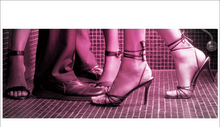From AMO and OMA's website
In the late nineties, while working on the design for the new headquarters for Universal (currently Vivendi), OMA was first exposed to the full pace of change that engulfed the world of media and with it the increasing importance of the virtual domain. It led Rem Koolhaas and the Office for Metropolitan Architecture (OMA) to create a new company, AMO, exclusively dedicated to the investigation and performance in this realm.
While OMA remains dedicated to the realization of architectural projects, AMO applies architectural thinking in its pure form to questions of organization, identity, culture and program, and define ways - from the conceptual to the operative - to address the full potential of the contemporary condition.
AMO is now a research office that embodies both the professional experience of OMA and knowledge generated by the Harvard Design School Project on the City. Supervised by Rem Koolhaas and Reinier de Graaf and with a core staff based in Rotterdam, New York and Cambridge, Massachusetts, AMO has consolidated a series of existing and new professional collaborations and cross-disciplinary partnerships.
AMO’s work is to develop new models of thinking about systems and to create clearly considered blueprints for change. AMO often works parallel to OMA for the same clients, providing extra services in the domains of organization and identity while, at same time, work on the design of a building is being conducted. This is for instance the case for fashion house, PRADA: while OMA worked on the design of five epicentre stores (including New York, San Francisco and Los Angeles), AMO worked on PRADA’s in store information technology, the website and media content. This has also led to work on PRADA’s advertisement campaigns, websites and general business consulting.
AMO has acted as a consultant for WIRED - a magazine on the impact of technological inventions on contemporary society - and published a guest edition. AMO’s resume also includes work for Universal Studios, Amsterdam Airport Schiphol, Harvard University, Conde Nast and Ikea.
Most notably AMO was involved in a brainstorm on the visual communication about Europe organized by the European Commission. The coloured `barcode`, one of the results of this brainstorm, has received full attention of the media, touting it a `new European flag` replacing the twelve gold stars. In 2006 the barcode was adopted by the Austrian Government as a symbol of its European Union Presidency.
AMO’s resume also includes work for Universal Studios, Amsterdam Airport Schiphol, Harvard University, Condé Nast, Heineken, and Ikea. Recent works include the development of in-store technology for Prada, a strategy for the future of Volkswagen, a strategy for TMRW, new organic fast food chain and work for Platform 21, new design institute in Amsterdam.
In summer 2005 AMO curated an exhibition titled ‘Expansion & Neglect’ for the prestigious Venice Biennale which explored the expansion of the world’s museums and art galleries and investigated whether large extensions were necessary. For the 2006 Venice Biennale AMO explored the rise of The Gulf cities, followed by the book, Al Manakh, which was published in autumn 2007, coinciding with OMA’s continued architectural and theoretical presence in the Middle East. Early 2008 AMO curated ‘Dubai Next’ at Vitra Museum in Switzerland which was an exploration of the challenges of change and tradition in Dubai.
Currently AMO is working for the Hermitage Museum (St. Petersburg) and for fashion house Prada. In addition it is engaged in studies for the European Union and various OMA projects.
Tuesday, March 10, 2009
Subscribe to:
Post Comments (Atom)







No comments:
Post a Comment